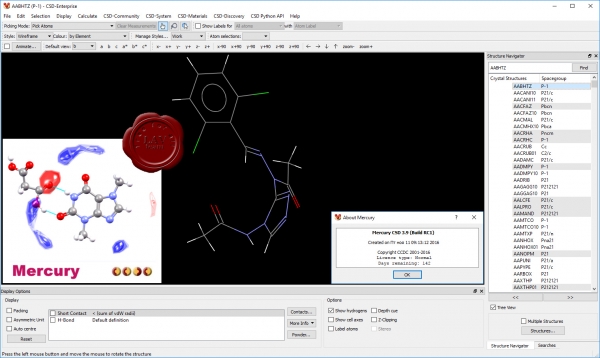
The Cambridge Structural Database (CSD) is the world’s comprehensive and up-to-date database of fully validated crystal structures. The 2017 release contains over 840,000 entries – an impressive increase of more than 55,000 entries! Containing important and unique structures not available anywhere else, the CSD is used by scientists worldwide and provides the complete crystal structure database for chemists working with any organic and metal-organic compounds.
The 2017 release contains targeted enhancements to a record-breaking 73,985 existing CSD entries, including:
- Enrichment of pharmaceutical structures, including addition of DrugBank IDs.
- Addition of validated metal oxidation states to over 21,000 entries.
- Inclusion of article DOIs for many older entries.
- Manual addition of structures from non-electronic data.
- Enhancement of many entries from 35 years of historical structures.
The CSD-System brings you essential crystallographic and structural chemistry capabilities to deliver knowledge from the CSD: powerful 2D/3D search, extensive geometry and interaction analysis, high impact graphics, as well as connectivity via the CSD Python API.
The exciting new CSD Python API has been improved for usability including:
- Seamless installation of the CSD Python API within the CSD 2017 release.
- An upgraded CSD Python API menu in Mercury with even more scripts.
Enhancements to Mercury and ConQuest including the ability to:
- Make use of touch-screens with Mercury for pinch, pan and zoom.
- Sketch a molecule within Mercury and convert to a 3D model.
- Perform additional crystallographic transformations in Mercury (such as inversion, switching space group settings or changing origin choice).
- Utilise two new metal-organic framework (MOF) subsets within ConQuest.
CSD-Discovery provides in one place all the tools you need for discovering new molecules.
Our focus on quality and usability continues through improvements in our leading docking software GOLD including the ability to:
- Make the most of your unlimited processes with streamlined licensing on clusters.
- Automate and integrate preferred workflows with our first implementation of GOLD in the CSD Python API.
- Receive faster more robust development of GOLD in the future as a result of extensive updates to the underlying code.
No protein structure? No problem! To complement the structure-based virtual screening capabilities of GOLD, CSD-Discovery now includes a complete ligand-based workflow allowing you to:
- Produce experimentally realistic ensembles of conformers using our CSD-driven Conformer Generator.
- Generate your pharmacophore from known binders using the improved Ligand Overlay application.
- Screen your virtual library using the Field-Based Ligand Screener in the CSD Python API.
Key to usability is, of course, education, so watch out for a series of new GOLD tutorials, in line with other new videos covering many application areas of the CSD-Enterprise family.
CSD-Materials helps you explore exciting new materials through analysing intra- and intermolecular interactions within the lattice, allowing you to understand your material’s behaviour and refine its properties.
In line with our quality and usability push, we’ve made a number of improvements based on work with our Crystal Form Consortium including:
- Enhancements to the graphical user interface for studying crystal packing similarity and dissimilarity.
- Significant advances in the layout and usability of the Hydrogen Bond Propensity application.